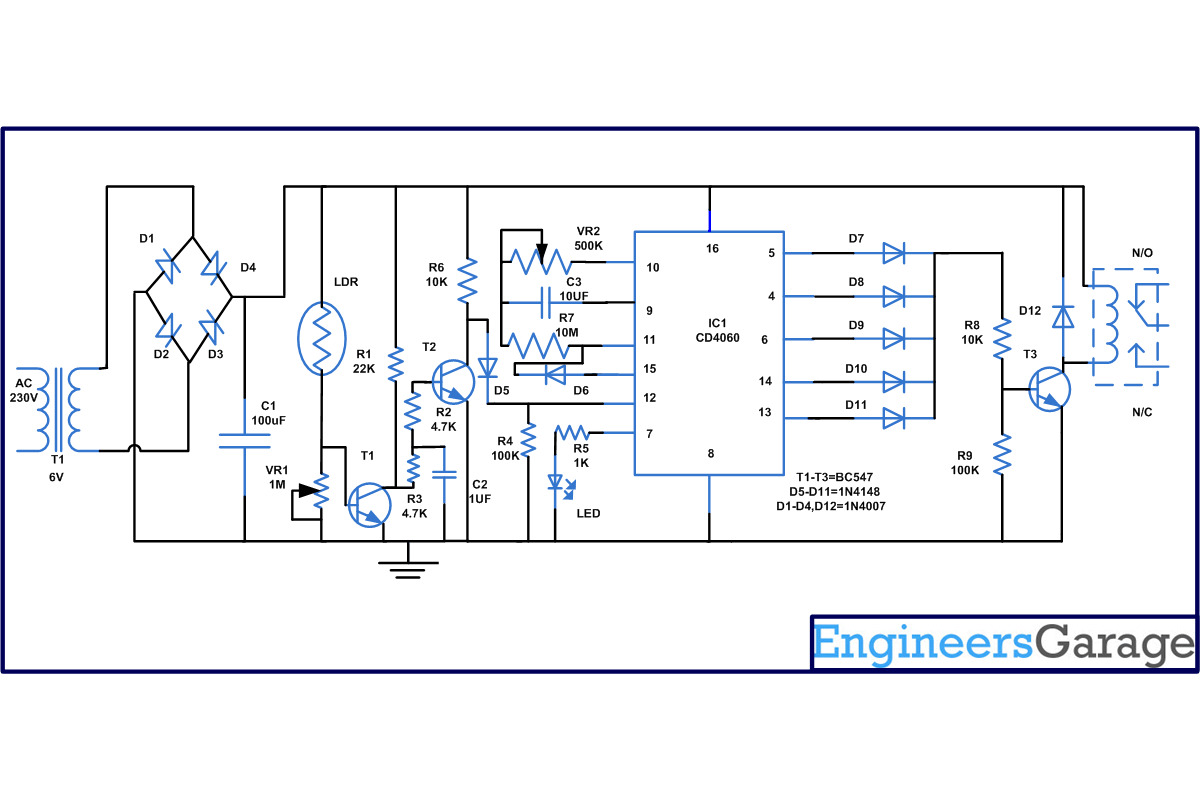Many people have habits to sleep while listening to music. So, device remains switched ON for the long durations which lead to wastage of energy. To avoid this, we have described a simple power off timer circuit which automatically become OFF after the set time. In this circuit, device become on while sensing the darkness , hence whenever you switch off the light, CD player connected to relay becomes ON and after set time it becomes OFF so there is no need to off the device as it turn off automatically so there is no wastage of electricity also.
The circuit is built around the CD4060, LDR and few more components. IC CD4060 is a 14 stage ripple carry binary counter, divider and an oscillator. Its built in oscillator is main feature of this IC that’s why it can be used in numerous application like flasher, clock generator in timer circuits. LDR is a light dependent resistor its property depends upon the intensity of light falling on it.
Here, IC1 is working as frequency dividing circuit. Its inbuilt oscillator is based on three inverters. The basic frequency of the internal oscillator is determined by the value of the capacitor connected to its pin 9, and the resistor connected to pin 10. By increasing or decreasing the value of capacitor and resistor, we can change the time delay for the period of on and off. Internally, the oscillator signal is applied to the first bistable which drives the second bistable and so on. Since each bistable divides its input signal by two, a total of fifteen signals are available, each of half the frequency of the previous one. Output Qn is the nth stage of the counter, representing 2n, for example Q4 is 24 = 16 (1/16 of clock frequency) and Q14 is 214 = 16384 (1/16384 of clock frequency). Note that Q1-3 and Q11 are not available.
Working of the power off timer circuit is very simple. Here, we have used LDR as a sensor which is connected to the base of the transistor. We have connected the variable resistor with the LDR so that you can adjust the sensitivity of the LDR. During the day time LDR will not conduct as a result LED1 remains off and shows that IC1 is not conducting. But in night resistance of LDR increases and transistor T1 is driven to cut off. This makes transistor T2 to also conduct. At this time pin 12 of IC1 goes low and counter of IC starts. At first, LED starts blinking, indicating that oscillation of IC started. After a minute pin 5(Q5)of IC1 goes high as a result transistor T3 start conducting and the device connected to relay become on.
After a preset time in our circuit 40 minutes pin15(Q10)goes high and remaining output become low and the relay de energies as a result device connected through it become off. We have connected a diode between pin15 and 11 because when output Q15 goes high it disables the IC so that device should not on again until next night.
For power supply we have used a step down transformer with 4 diodes.
Circuit Diagrams
Project Components
Filed Under: Electronic Projects



Questions related to this article?
👉Ask and discuss on Electro-Tech-Online.com and EDAboard.com forums.
Tell Us What You Think!!
You must be logged in to post a comment.